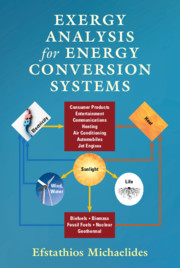Book contents
- Exergy Analysis for Energy Conversion Systems
- Exergy Analysis for Energy Conversion Systems
- Copyright page
- Dedication
- Contents
- About the Author
- Preface
- Symbols
- Abbreviations
- 1 Introduction
- 2 Exergy
- 3 Energy Conversion Systems and Processes
- 4 Exergy Consumption and Conservation
- 5 Exergy in Biological Systems
- 6 Ecosystems, the Environment, and Sustainability
- 7 Optimization and Exergoeconomics
- Index
- References
5 - Exergy in Biological Systems
Published online by Cambridge University Press: 19 March 2021
- Exergy Analysis for Energy Conversion Systems
- Exergy Analysis for Energy Conversion Systems
- Copyright page
- Dedication
- Contents
- About the Author
- Preface
- Symbols
- Abbreviations
- 1 Introduction
- 2 Exergy
- 3 Energy Conversion Systems and Processes
- 4 Exergy Consumption and Conservation
- 5 Exergy in Biological Systems
- 6 Ecosystems, the Environment, and Sustainability
- 7 Optimization and Exergoeconomics
- Index
- References
Summary
Solar irradiance is the source of exergy for all living organisms. Photosynthesis in primeval organisms generates the food for the other species. It also provides the chemical energy in biomass that is used as fuel. Energy conversions in humans produce mechanical work using food as the exergy source. The food intake; the metabolic and thermic processes in the human body; the production of adenosine triphosphate (ATP); and the conversion of the ATP energy into mechanical work are analyzed using the principles of thermodynamics. An interesting conclusion is that humans have evolved as inefficient energy conversion systems, with food-to-work exergetic efficiencies close to 10%. The analyses and a number of examples in this chapter elucidate the application of thermodynamics to biological processes including: production and use of biomass; exergy value of nutrients; exergy spent for vital processes, such as respiration, blood circulation, and maintenance of body temperature; and exergy spent in sports, such as weight-lifting, walking races, the marathon, and bicycling. The chapter also surveys the relationship between exergy destruction, the state of health, aging, and life expectancy.
Keywords
- Type
- Chapter
- Information
- Exergy Analysis for Energy Conversion Systems , pp. 201 - 250Publisher: Cambridge University PressPrint publication year: 2021



